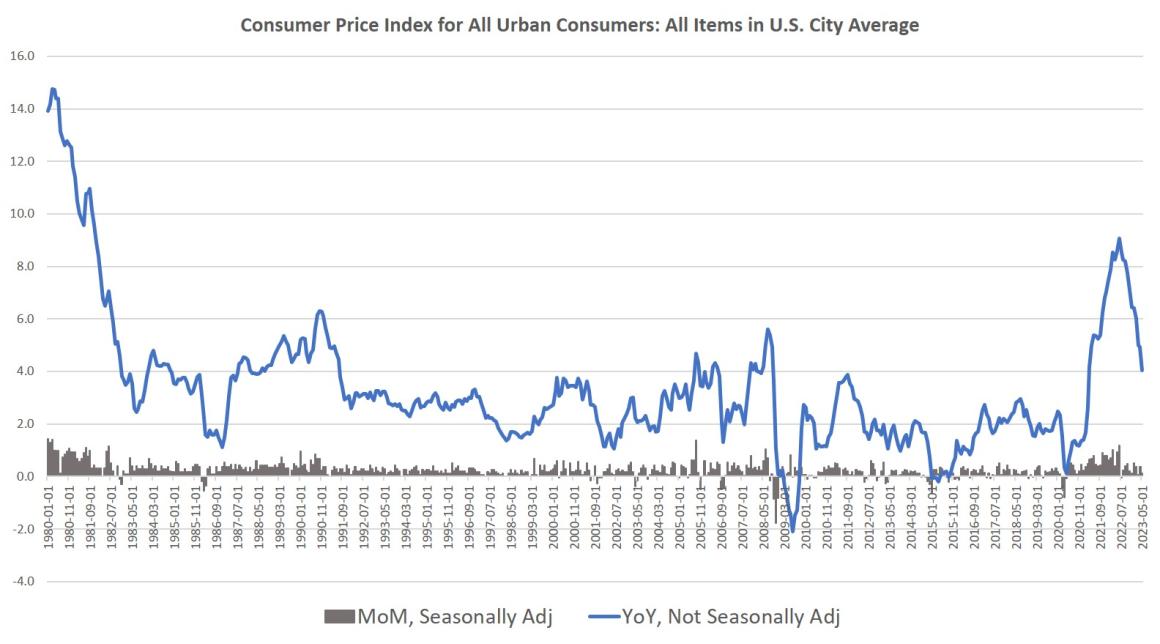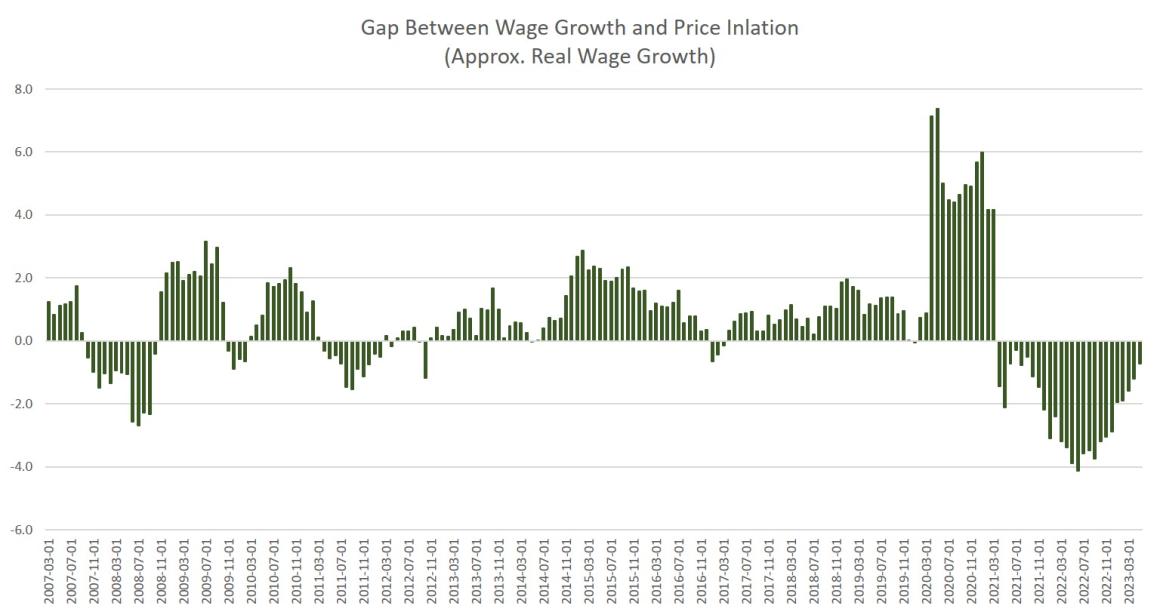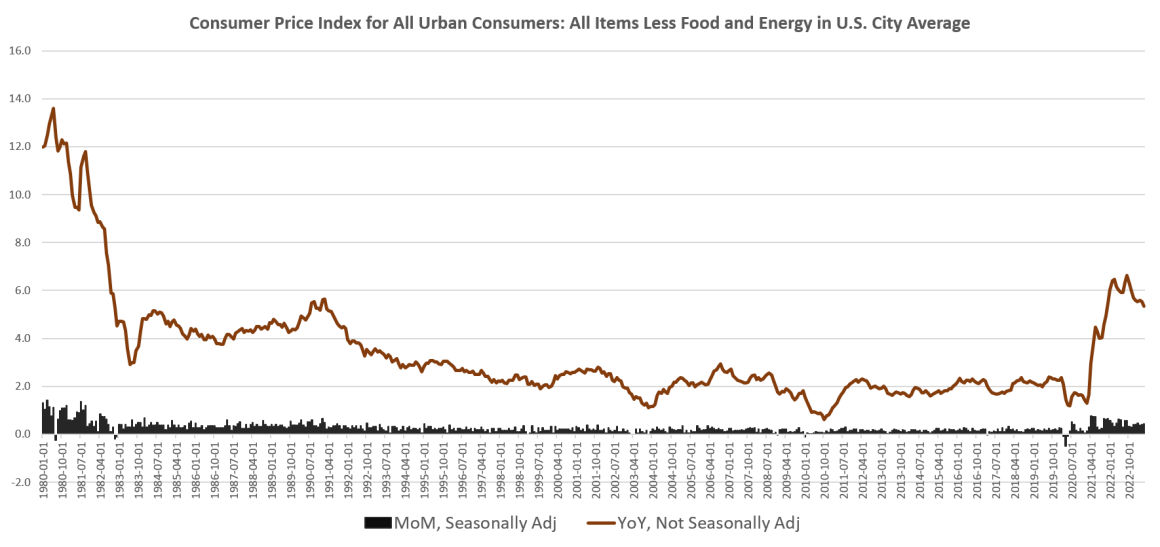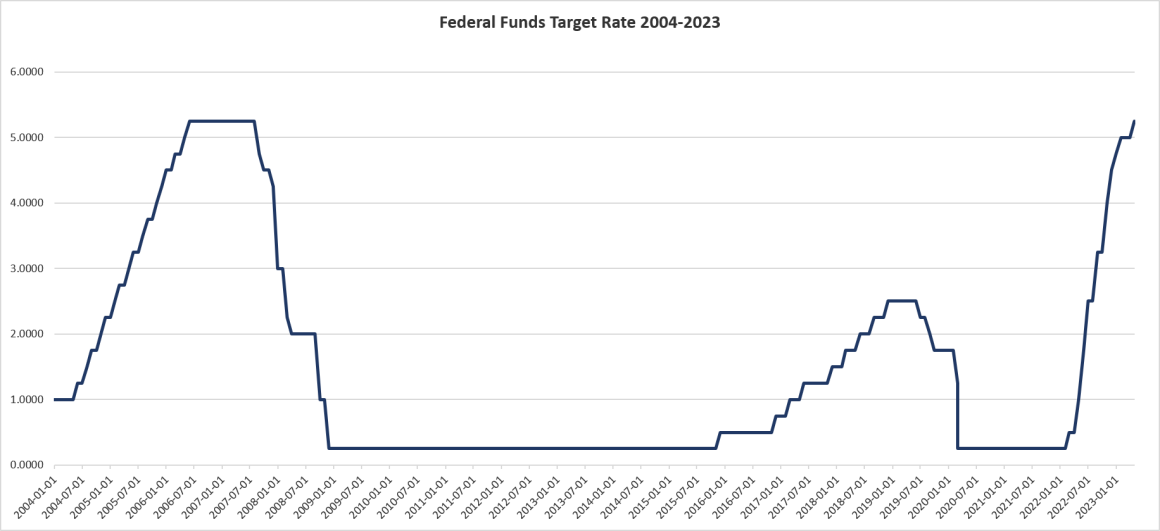The federal government’s Bureau of Labor Statistics (BLS) released new price inflation data Tuesday, and according to the report, price inflation during May decelerated, coming in at the lowest year-over-year increase in twenty-six months. According to the BLS, Consumer Price Index (CPI) inflation rose 4.0 percent year over year in May before seasonal adjustment. That’s down from April’s year-over-year increase of 4.9 percent, and May is the twenty-seventh month in a row with inflation above the Fed’s arbitrary 2 percent inflation target. (More precisely, the Fed targets a two-percent rate in the PCE measure.)
Meanwhile, month-over-month inflation rose 0.1 percent (seasonally adjusted) from April to May. That's down from April's month-over-month gain of 0.4 percent.
May’s year-over-year growth rate is down from last June’s high of 9.1 percent, which was the highest price inflation rate since 1981. The BLS's CPI inflation rate of increase has now slowed from June's high for eleven months in a row.
Growth in CPI inflation has indeed slowed, and this reflects slowdowns in energy, gasoline, used cars and trucks. Food prices continued to rise at levels not seen since 1989 and 1990—with the exception of 2022's 40-year highs. Food prices in May were up by 6.7 percent, year over year, in May. Prices in energy overall fell 11.7 percent, year over year, with gasoline prices dropping 19.7 percent over the same period.
Shelter prices have seen some of the most robust growth in recent years, and increases have remained among the highest we’ve seen since the 1980s. During May, however, year-over-year growth in shelter prices slightly slowed as shelter prices increased 8.0 percent in May. That's down from April's year-over-year increase of 8.1 percent, and was the second month of slowing increases for shelter prices.
Meanwhile, May was yet another month of declining real wages, and was the twenty-sixth month in a row during which growth in average hourly earnings failed to keep up with CPI growth. According to new BLS employment data released earlier this month, nominal wages grew with hourly earnings increasing 3.4 percent year over year in May. But with price inflation at 4.0 percent, real wages fell again.
Moreover, once we look beyond food and energy—the two most volatile components of the CPI—price inflation has barely slowed at all, and has even accelerated month over month. This so-called "core inflation" rate of increase fell to 5.3 percent in May, but that's not down much from April's growth rate of 5.5 percent, or from the 40-year high of 6.6 percent reached last September. Month-over-month, the CPI increased by 0.4 percent in May (seasonally adjusted). That's the second month in a row of month-over-month growth in price inflation.
The market's reaction to this very slight deceleration in price inflation has been to interpret it as a victory over price inflation and to assume that the Fed's FOMC will now "pause" on interest rate hikes. According to The Hill, for example:
While the labor market has held strong amid the rate hikes, the combination of falling inflation and a slowdown in the broader economy has given the Fed reason to hold off on further increases.
Countless analysts on Wall Street have been making this same prediction for many months at this point, but Powell and the FOMC have repeatedly raised rates, pointing to jobs data as evidence that the economy has not sufficiently cooled to bring down price inflation. The narrative is now this: "price inflation is over. Now's a great time to cut interest rates!"
Will Powell and the FOMC "pause" rate hikes? We'll know at Wednesday's press conference. At the last FOMC press conference, Jerome Powell hinted that the committee has taken a dovish turn, announcing that additional rate hikes can no longer be assumed. For what it's worth however, at least some members of the Committee are maintaining the appearance of continued relative hawkishness. Last month, New York Fed President John Williams insisted that "We haven't said we are done raising rates" and "if additional policy firming is appropriate, we'll do that. ...I do not see in my baseline forecast any reason to cut interest rates this year."
It's unclear that the Fed has much appetite for additional rate hikes, however. With the FOMC's latest 25-basis-point hike to 5.25 percent, the target federal funds rate is now at the highest it's been at any time since 2001. The target rate was also at 5.25 percent on the eve of 2008 financial crisis.
What Do Interest Rates Have to Do with Price Inflation?
When discussing the state of the economy and the Fed's interest-rate policy, the general media narrative is that the Fed can "solve" mounting price inflation—or "win the inflation fight"—by "raising" interest rates.
Not surprisingly, the media—and most economists and Wall Street analysts—miss the point here. The key issue here is not that the central bank is "setting" the "wrong" interest rate. The problem arises from the fact that the Fed has long been relentlessly forcing down interest rates to satisfy various politically determined "needs." The result has been monetary creation which in turn leads to asset price inflation and consumer price inflation. What are the "correct" interest rates? We'll never know so long as the Fed keep intervening in markets. In truth, however, without ongoing Fed meddling in interest rates, most market rates would likely be much higher than they currently are. Moreover, allowing markets to actually determine interest rates would be among the most effective ways to "win" against inflation. But don't expect any central bankers to entertain that idea any time soon.
Instead, the Fed has been doing the opposite. Traditionally, the Fed has been forcing down interest rates through the open market operations of the Federal Open Market Committee. That's bad enough by itself. The process, however, was put on steroids in the wake of the 2008 financial crisis. Ever since then, the Fed has repeatedly bought up trillions of mortgage-backed securities and US government Treasurys. This was done to satisfy at least two policy goals: it kept interest low on government debt, and it propped up the values of assets held by major banks.
Without this intervention in the marketplace, it's a safe bet that market interest rates would be considerably higher than they are and have been for the past decade. Some economists have attempted to claim otherwise, insisting that the "natural" interest rate has been coming down, and that the central bank has barely had anything to do with it. The absurdity of this claim is revealed in the fact that these economists also oppose an end to the Fed's open market operations. Of course, if the Fed were "barely doing anything" to push down interest rates, then a total cessation of Fed meddling in asset markets would have virtually no effect. Everyone knows that in real life, however, interest rates would almost certainly head upward swiftly if the Fed reversed its low-interest-rate policy. In addition to ending its open-market operations, the Fed could do that by selling off the trillions of dollars worth of securities in its post-2008 asset hoard.
Indeed, the only reason the Fed is now allowing interest rates to creep upward at all is because price inflation has become a political problem. It's a problem because the flip side the Fed's low-interest-rate quest has been monetary creation. Forcing down market interest rates tends to increase credit through the commercial banking system—and in the case of the Fed's asset-purchase schemes—efforts to push down interest rates lead to outright "money printing." All this easy money of the past decade led to 40-year highs in price inflation. That has given us 26 months of falling real wages, soaring gas prices, and runaway home prices. It all presents a myriad of difficulties for ordinary workers and families who attempt to plan for the future and keep their incomes ahead of expenses. Historically, price inflation tends to be very unpopular among voters, and often leads even to civil unrest—as any observer of European or Latin American history can see.
Thanks to the soaring price inflation of the last year, the Fed is now attempting to somehow "win" against inflation by doing the absolute bare minimum in terms of reversing its longstanding policy of forcing down interest rates again and again. Because easy money helps inflate asset prices and create economic bubbles, Wall Street—which is now thoroughly addicted to easy money—is hoping the Fed will soon return to ramming down interest rates yet again.
Read More:
- "Yes, the Fed Really Is Holding Down Interest Rates" by Joseph Salerno
- "Money Creation—Not Low Interest Rates—Is Behind the Boom-Bust Cycle" by Joseph Salerno
- "How the Fed Is Enabling Congress's Trillion-Dollar Deficits" by Ryan McMaken
Tags: Featured,newsletter






























